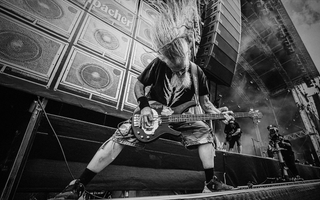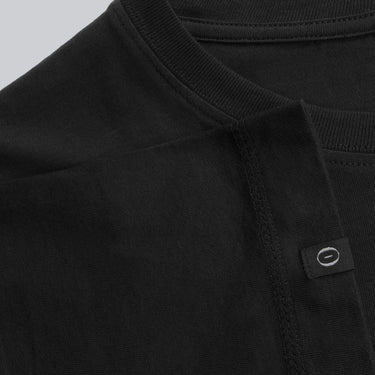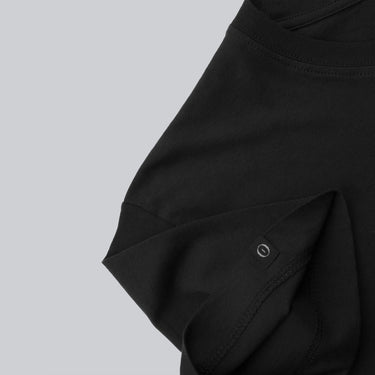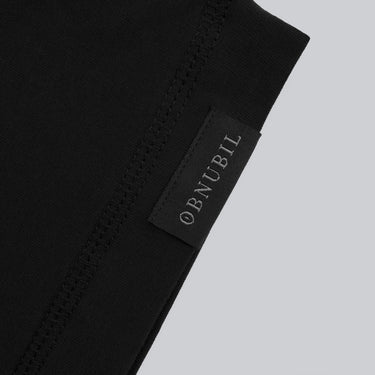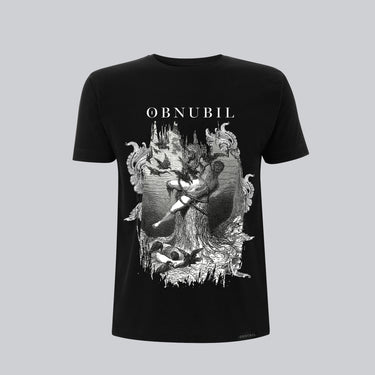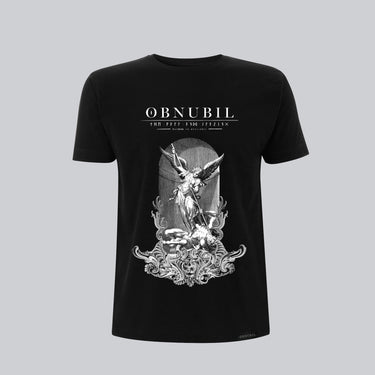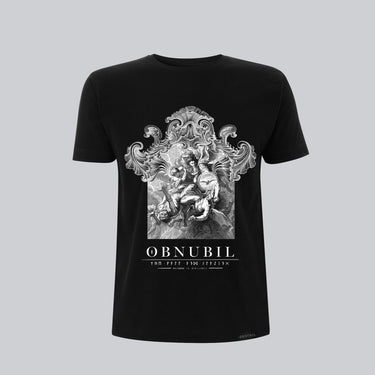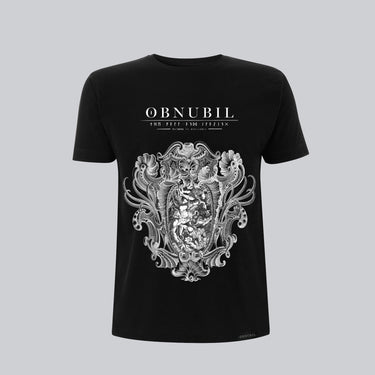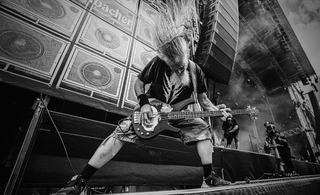
It’s a genuine pleasure to welcome André Skaug — the powerhouse bassist whose low-end grooves have driven the aggressive, groove-metal pulse of Clawfinger since the 1990s. With decades of touring, multiple studio albums, and a knack for blending raw intensity with rhythmic finesse, André has helped shape a sound that’s as heavy as it is tight. I caught up with André to dive into his journey: from picking up his first bass at ten, to stepping into the rehearsal room for the early Clawfinger era, and continuing today to push boundaries both on stage and in the studio. Whether discussing the evolution of his gear, the balancing act between groove and aggression, or the off-hours on tour that become legendary, this conversation takes you behind the scenes of a musician who lives and breathes his craft.

INTERVIEW
OBNUBIL: Hi André! Thanks so much for taking the time—it’s a real pleasure to speak with you. You’ve just come out of a pretty intense summer of shows, including one at Wacken, which must have been quite an experience. Before we dive into your journey as a bassist and musician, I’d love to start on a more personal note: how are you feeling after such a packed run of performances? Did any of those shows—whether the big festival moments or the smaller, more intimate ones—leave a particular mark on you or spark a new sense of creative energy going forward?
André: Hello there, and thanks for asking. Yes, the summer has been kind of busy. In combination with other work I've been working 7 day a week since end of April, so it will be nice to have some days off now. Otherwise, I feel very well! Wacken was the most massive one this summer, but we finished of at Rebel Rebel Festival in Sofia/Bulgaria. I just have to say WOW, that audience and the feedback we got. Man, I have no words to describe that actually. That really give some extra Energy, and not only there and then, but for weeks.
OBNUBIL: Every bassist has that origin story moment — sometimes it’s falling in love with the low end on a record, sometimes it’s just being the last guy left in a group of friends when the guitar spots were already taken. Can you take us back to the very beginning of your journey with the instrument? Was the bass your first love, or did you stumble into it almost by accident? And what do you remember about the first time you actually felt the vibration of those low notes in your body? Which bass players or albums first made you want to pick up the instrument? And when do you think you first broke free from copying and started finding your own voice on the bass?
André: I started out trying different instruments, and me and my brother both wanted to play the drums, cause my father was a priest in the pentecostal church, we got to start playing in the children's choir, and my twin brother was the” lucky” one to get to play the drums. So I started out playing my bass as a 10 year old boy, and I I liked it pretty fast, even though I wanted to play the drums. I first went in to Gospel, and it turned fast to Fusion like, Mezzoforte, Spyro Gyra, Marcus Miller, and most of all Level 42. I sat down with the my first level 42 tape and trying to pick out Mr Pink, playing along, rewinding back, and over and over again until I got it right. It took a while compared to these days and internet. The first real low note experience I had was at 16. Then I started to play in my first Rock/metal band, and in the rehearsal room they had a bass amp and a 4x12 cabinet and I remember that it was heaven compared to all earlier experiences playing my Bass. It felt so overwhelming and powerful. The finding my self journey probably started when I was 13-14 years old, but I think I Started to be more conscious about it when I joined Clawfinger and started Jamming and Finding new riffs and ideas for new Clawfinger songs, around 1992.
OBNUBIL: Many bassists remember their very first instrument almost like a first car — imperfect, maybe cheap, but unforgettable. What was your very first bass, and do you remember what it felt like under your fingers compared to what you play today? Did you obsess over string gauges, setup, and action right from the start, or were you more of a “plug it in and go” player in those early days?
André: I started out on a Yamaha BB 1600, and that had really high action. It was a bit of a struggle to play sometimes, but it strengthened my fingers, so that was good. When I first started playing, I was only thinking of learning. I didn't know anything about changing the action, strings and so on. Actually, I never cared so much about how it feels playing, as long as its possible to play it, and also the sound on stage is not so important, as long as I can hear my bass enough to know that I'm in the right tune.
OBNUBIL: You joined Clawfinger in the early ’90s, a time when the band was really shaping a unique sound that combined industrial elements, groove-heavy riffs, and politically charged lyrics—a period that was not the most typical playground for a bass player. Unlike traditional rock or metal bands, where the bass often just locks in with the kick drum, Clawfinger’s early music left a lot of space for basslines to either grind mechanically or groove almost like hip-hop. Looking back, how did you approach defining your role in that sonic landscape—did you feel more like the “engine room” holding everything together, or did you consciously search for places where the bass could poke through and add its own personality? And if you compare those early days of experimentation with how you would record or perform the same material today, what would you do differently as a player with all the extra years of experience behind you?
André: I heard in my early days as a bass player that the bass should be the glue between the guitar and the drums. So I have always struggled to be in between there, and always searching for the ultimate groove. But also when jamming with Clawfinger, there was always a room for a bass player to come up with ideas that the other guys could develop, and with my fusion background it became a lot of influences from that kind of bassplaying. You can hear one example in the verses in “Stars and Stripes”, where the riff is influenced from a Jaco Pastorius song (The Chicken). “Runner Boy” is an another example, where I'm influenced by Stuart Hamm (Flow my Tears). A huge metal influence was of course “ In the Meantime” with Helmet. About recording these songs today, perhaps I would change some sound maybe, but probably I wouldn't do much of a change at all.


OBNUBIL: Many bassists talk about “fighting for space in the mix,” especially in guitar driven metal bands, but Clawfinger’s sound often gave the bass a unique grit and authority, almost a second guitar in some moments, and almost percussive in others. When you think about your gear choices back then—amps, cabs, EQ curves, playing techniques—what were the most important decisions that allowed your bass to cut through that wall of samples, guitars, and vocals? Could you walk me through one particular song where you really had to “engineer” your sound to make it work live or in the studio?
André: It's all very simple. We have a Sound Guru in our band named Jocke Skog. He will always help out getting the right sound at the right time. He also mix our Records nowadays, so if you need someone clever to mix your stuff, contact our Keyboardplayer Jocke Skog. We found out very early in the 90's that we couldn't use any bass gear, cause we couldn't get the right kind of distortion from that. So I invested in the first Sansamp (for guitars), and after that it just went on with Line6 pod, Ax/Fx, playing via Computer and Apps, all the way to a Line6 HX Stomp Box that I use today. Guitar gear all the way. Soundwise I can not pick one particular song. We record everything with DI signal, and then its up to Jocke and his magic to make it sound “top of the class”.
OBNUBIL: Clawfinger often fused aggressive riffs with grooves that feel almost funky or hip-hop inspired, which isn’t common in the Scandinavian metal scene. As a bassist, you’re constantly shifting between grinding eighth-note precision and more open, flowing grooves. How did your personal musical background prepare you for that stylistic balancing act? Were there moments when you deliberately pulled influence from funk, jazz, or even electronic music to bring something unexpected into the Clawfinger sound?
André: All my years as a bass player before Clawfinger I was listening to Jass, Fusion, Rock Metal, Gospel, Blues, and so on. For the unexpected stuff it was more the playing style than the sound that mattered (see answer at question 3).
OBNUBIL: The bass guitar is often described as an “invisible instrument”—you don’t notice it when it’s there, but you immediately miss it when it’s gone. But in Clawfinger, the bass seems to constantly oscillate between being felt in the chest and being clearly heard as a melodic and rhythmic anchor. Did you ever think of your role as translating “rage into groove”—turning the aggressive lyrical message into something that physically moves people on the low end? And if so, how do you think your playing helped carry the political and social weight of Clawfinger’s songs beyond just the notes?
André: To me, it has always been about the groove in the first place. Of course there is a cooperation between us musician and the lyricist, and I will always support the message the band conveys, but that is nothing i think about when performing or making music. Then it's all about rhythm and groove, feelings and having fun. And the second thing is that the lyrics often come after the music is done.
OBNUBIL: There’s a certain physicality to the way you play—you attack the strings in a way that seems closer to a percussive instrument, almost like you’re drumming on the bass at times. Was that a conscious choice from the start, or did it evolve as you tried to keep up with the intensity of Zak’s vocals and the machine-like guitar riffs? If we imagine you were to give a “bass-only breakdown” of a Clawfinger track, which song would reveal the most about your philosophy of how bass should feel in heavy, groove oriented music?
André: If you listen to “I don't care” from the album Deaf Dumb Blind, you will find a lot of my thinking about bass and metal around the early 90 ́s (for the playing style, its a bit influenced by Suicidal Tendencies song “Send me The money”). I think it's more like we evolved together as well as we tried to keep up with each other. That's a bit hard to answer, cause there is, and we have so many shades of heavy Groove oriented music. If I really need to answer that question, it has to be “Two Sides”.


OBNUBIL: You’ve spent decades on the road with Clawfinger, touring across Europe, North America, and beyond, sharing stages with countless bands and living the life of a full-time road warrior. Looking back, was there ever a tour where it all felt almost magical—where the music, the personal chemistry within the band, and the connection with the audience just aligned perfectly? And on the flip side, thinking back to certain moments since the early ’90s, were there times when the shows themselves were amazing, but everything around it—the pressures of the industry, the grind of travel, or the general situation of life on the road—made it feel less like a dream come true and more like a test of endurance?
André: Oh man, it has been 32 years of touring, and I'm starting to feel like a Rolling Stone soon, Ha-Ha! When I think of it, I always had a good feeling around the band, the tours and especially the audience, but I don't think its possible to get all those variables to be perfect at the same time. I mean, the first tours with Alice In Chains, and then Anthrax was pure magic. The Monsters Of Rock tour in South America had its very special magic. The Mutter tour with Rammstein was magical in a different way. This festival tour of this summer has been magic, cause we are still able to do this after so many years and still have a fantastic audience, that we share a whole lot of Love with! That's the way I think you have to look at it. We decided to do a 7 week tour in the late 90's. That was a test of endurance. We decided that we would never go more than 3 weeks in a row without going home in between, if we still wanted the band to exist. But lack of sleep, and long van travels is mostly the reason for getting tired of the touring business. Especially festival season with a lot of early flights and late night shows.
OBNUBIL: After so many miles on the road, some cities and countries must start to feel like second homes. Are there particular places where you think, “Ah yes, this is my people—plus the food doesn’t try to kill me”? Beyond the gigs themselves, what’s your favorite non-musical part of touring—chasing down local food obsessions, developing bizarre off-day rituals, or maybe collecting strange gas station souvenirs that only make sense at 3 a.m. in the middle of nowhere?
André: I think that must be Germany. That is different and changing all the time, it could be everything from doing Rollerblades, to playing video games, or buying strange hats.
OBNUBIL: Talking about souvenirs: every tour seems to leave you with weird little treasures, from novelty T-shirts to items you didn’t even know existed. What’s the most bizarre or hilariously useless thing you’ve brought back from the road, and do you display it proudly—or hide it in shame somewhere in your studio?
André: When we played Monsters of Rock -95, I brought home a Waterstick. Its an instrument the Chileans made from a Cactus. When you turn it, it will almost sound Like waves. They made those so they could copy the sound, and hear the ocean. We sampled it once in the studio, but after that, it has been hanging on my wall for almost 30 years now. The other thing I got was a Thong from Slash & the Snakepitt, after I yelled at him that he was behaving like a spoiled shithead trashing the dressing room. I don't know if he felt bad, and that's why he gave it to me, but what should I do with a thong with their band logo on?
OBNUBIL: If someone filmed a “making-of-the-bassist” montage of your life, what totally absurd behind-the-scenes moment would you insist had to be in it? Changing strings mid-gig in a thunderstorm? Eating something that might technically be alive? Or a completely random, unexplainable tour tradition that only makes sense in hindsight?
André: I would love to have on tape when I got Peter Steel / Type O Negative to crawl into my band t-shirt size Large for a picture to the vocalist in Black Dog. ( I also had a band called “Black Dog” back then, where our vocalist was a total Peter Steel fan). He was so huge that the t-shirt only reached just above his navel, and it took him, for sure, 5 minutes to get into it. That was a good laugh. Other than that, we always sing as loud as we can during our shuttle drives from festival to hotel after show. I don't know if it has to do with alcohol or not.
OBNUBIL: Your musical path has always carried a sense of intensity, whether through the sheer energy of your live performances or the way your basslines ground and drive the music forward. Looking ahead, what’s on the horizon for you personally as a musician? Are there new projects, collaborations, or perhaps even fresh directions outside of heavy music that you’re eager to explore? What should people keep their ears open for when it comes to your next steps?
André: I have been writing some songs lately. That mean, I started slowly in the pandemics, and it's still a forthgoing process, so maybe one day there will be a solo album? Meanwhile Im helping my son who just done his Metal debut and released his first song with his “Prevailed”, together with Mikael Sehlin from Amaranthe.
There will also be a new Clawfinger album released 22 of February, almost 18 years after the last one. We just released these two singles.
OBNUBIL: It’s been amazing to dive into your story and hear your perspective on the instrument and the journey behind it. Before we close, is there something you’d like to say directly to the listeners who’ve followed and supported you throughout the years? Whether it’s advice for young bass players, gratitude for the fans, or even just a thought about what keeps you motivated—what final words would you like to leave them with?
André: I will say as I always say to people I meet on the road. Without you guys, none of this would be possible. I'm really humbled that I'm still being able to do all of this, and that's thanks to all of you guys out there. I'm so thankful for all of you and your support! Lets keep up the collaboration. The more we give, the more we get. / Take care, and Stay Metal!!!
Interview done October 2025. Photos by Peter Bjöns.


